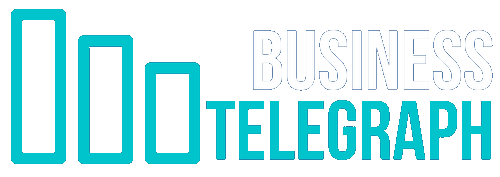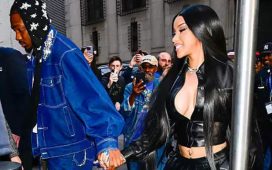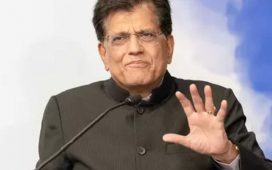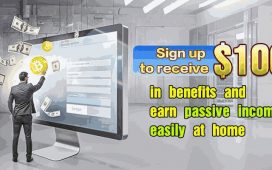Jordan Moon (left) and Macaulay Beasley (right) use OneCourt tablets at the Phoenix Suns vs. Minnesota Timberwolves game in Phoenix on March 2.
Courtesy: Phoenix Suns
During a break at the March 2 game between the NBA’s Phoenix Suns and Minnesota Timberwolves, a player made a half-court shot that had the crowd buzzing at PHX Arena. Normally, that’s something Jordan Moon would’ve missed; as a blind person, he’d have to ask somebody else what just happened.
But while he didn’t see the shot, he could feel it. Moon was part of a group from Saavi Services for the Blind that was testing devices designed to help blind and low-vision people follow the game at their fingertips. The tactile tablets, made by Seattle-based startup OneCourt, modeled the layout of the basketball court and vibrated wherever the ball moved or something happened. A free throw, for instance — or a half-court shot.
When the ball swished through the net, the tablet vibrated. Moon and the group cheered along with the rest of the crowd.
“That was really cool, actually, because that was just something that wasn’t even a part of the game,” Moon, Saavi’s Phoenix center director, told CNBC. “It was just a part of the fan experience.”
Enhancing the fan experience for blind and low-vision people is the mission of OneCourt and other accessible tech startups, which in the past few years have partnered with pro sports franchises to bring their technology to fans at live venues.
Rollouts of these devices are still in the early stages, but they’re gaining steam. The devices are typically available at no cost to visitors, with a limited number available at each game, and they’ve reached organizations like Major League Baseball, the Premier League and the Olympics.
The technological landscape
Tactile tablets are one of the most popular categories of live-sports tech for blind people. Broadly, the tablet is like a miniature field: Vibrations throughout the device communicate information such as the location of the ball, scoring attempts and fouls. Buttons and audio can provide details like the score and time left in the game.
OneCourt has the largest footprint in the U.S. The startup, founded in 2021, broke through in mid-2024 when it partnered with T-Mobile and MLB to distribute its tablets at the All-Star Game.
After running a pilot program with OneCourt in 2024, the Portland Trail Blazers in January announced they would be the first professional sports team to feature OneCourt devices at all home games through the end of the season. The Sacramento Kings and Phoenix Suns followed suit.
Jerred Mace, founder and CEO of OneCourt, said the company views itself as the first “tactile broadcaster,” emphasizing the level of detail provided by the tablet’s pixel-like surface. With that mission in mind, he wants to introduce OneCourt into users’ homes in 2026.
“Our position as a broadcaster, I think it just broadens the view of accessible sports experiences,” Mace said. “No matter where you are, you want to be able to access the game.”
Other peers use a magnetic cursor on the tablet that moves as the ball does. Touch2see, based in Toulouse, France, has supplied its tactile tablets to Major League Soccer’s St. Louis City SC and the Rugby World Cup, among others.
Dublin’s Field of Vision, which also uses a magnetic ball, currently leases tablets to rugby and football stadiums in Dublin and Melbourne, Australia.
Field of Vision’s tactile tablet.
Courtesy: Field of Vision
Fine-tuning the experience
Companies said they’ve gone through many iterations of product design for their devices and that collaboration with blind and low-vision people has been integral.
Kunal Mehta, OneCourt’s user experience designer, said it’s been challenging yet rewarding to make the tablets accessible to blind people. Working on aspects like tutorial design, Mehta said he prioritizes minimizing the amount of effort required for users.
“Speaking with users in an environment where they are comfortable to share what they feel like and not necessarily what we want to hear, that’s definitely been an important piece,” Mehta said.
A key consideration for the tablets is how to make the experience as normal for users as possible. Most of these devices work throughout an arena, for instance, meaning users can sit with friends and family.
“We want to really open up the social aspect of live sports,” Touch2see sales director John Brimacombe told CNBC.
David Deneher, Field of Vision’s co-founder, told CNBC that discussions with blind fans led the company to prioritize portability for its tablets.
Given the fast pace of live sports, companies have emphasized rapid data transmission to the devices. OneCourt connects to the NBA’s real-time game data. Other companies use stadium cameras or install their own to communicate on-field action to users within milliseconds.
The financial model
Thus far, device activations in venues have been a mix of sponsorships and paid agreements.
Live Nation-owned Ticketmaster backed all three NBA deals with OneCourt, drawing from its social impact funding to sponsor five devices each in Portland and Sacramento and 10 devices in Phoenix. The Phoenix Suns/Phoenix Mercury Foundation matched Ticketmaster’s financial contribution.
Scott Aller, Ticketmaster’s senior client development director for the NBA, told CNBC that the partnership aligns well with the company’s mission.
“We’ve realized there is a very large coalition of visually impaired fans that have been attending events historically,” Aller said. “Now they have a whole extra element to really feel closer to the game, and that’s ultimately what we dream about every day.”
Touch2see usually employs a business-to-business model where the team or league foots the bill, Brimacombe said. But it also partners with corporations for certain events.
Visitors use Touch2see tablets at the Africa Cup of Nations football competition in 2024.
Courtesy: Touch2see
What users are saying
Blind and low-vision people who have tested these devices at games told CNBC that the technologies are promising but have room for improvement.
Moon and Macaulay Beasley were among several Saavi members to test the devices at the Suns game on March 2. Initially skeptical, Beasley said he was impressed by how he could follow the game with his fingers.
“It felt like I was watching the game again, because I used to have vision. So I felt more engaged with the crowds and more engaged with the game,” Beasley, an orientation and mobility instructor at Saavi, told CNBC.
OneCourt’s device offers auto-generated audio commentary, but Moon and Beasley said it would be even better if it connected directly to the radio broadcast that fills in information gaps such as who’s controlling the ball.
“I would say that the radio provides context, but OneCourt gives it color,” Moon said.
Mehta said he believes the tablets especially aid users in gaining spatial awareness. He said he never really understood how large a soccer field was, for example, before walking across one during product development.
Daniele Cassioli, a blind Paralympic water skier, tested Touch2see’s device at a November soccer match between Italian soccer clubs Cagliari Calcio and Hellas Verona. He told CNBC that using the technology helped him better understand “the story of the game,” like the strategies each team was deploying on the field.
He said he’d love for the device to be more interactive and lightweight. But Cassioli put his suggestions in perspective, highlighting progress in making sports more accessible since he first began waterskiing in the 1990s.
“Right now, we realize that we can deserve more,” Cassioli said.
A person using a Touch2see device cheers at a French national football team match.
Courtesy: Touch2see
Skepticism and the long-term view
Some accessibility experts said live-game devices for blind fans risk becoming another highly publicized technology for disabled people that disappoints in practice and eventually descends into obscurity.
Liz Jackson, a disabled nonacademic scholar and writer, in 2019 coined the term “disability dongle,” which she defines as “a well-intended, elegant yet useless solution to a problem [disabled people] never knew [they] had.” She said buzzy technologies marketed to disabled people often follow a predictable “announcement-to-abandonment cycle” and that above all, she questions how long these devices will be maintained.
Rua Mae Williams, a disabled assistant professor in user experience design at Purdue University, said tech startups often fail to consider long-term sustainability when developing their products. The tendency of such devices to become obsolete disproportionately harms disabled people, Williams added.
“When you’re talking about disabled people being the users of your product, you’re often talking about making them reliant on a set of hardware and software for daily functions with the knowledge that you intend to basically disappear within five years. And so if there’s no clear statement of sustainability of how this product will continue to exist no matter what happens to this company, that’s a major red flag,” Williams told CNBC.
OneCourt’s Mace said the company views its plans to bring the tablets to homes as key to sustaining the business.
“At the end of the day, OneCourt only exists if we continue to drive value for our fans,” he said. “The technology at home is one avenue through which accessibility can be sustained over time and ultimately broadened.”
Many of the deals that sports teams have inked with device developers are on a short-term basis. OneCourt’s current NBA agreements only last through the end of this season, though the Kings, Suns and Trail Blazers all told CNBC that they want to continue making the fan experience more accessible.
There are still major obstacles that blind and low-vision fans confront in order to attend live games. Saavi’s Moon said although he appreciates how OneCourt encourages blind people to participate in sports, he hopes guest services staff receive training to assist visitors, since he often experiences difficulties receiving accommodations and audio equipment at live events.
The issues go beyond the venues. Beasley said the app for Ticketmaster, the NBA’s official ticketing partner, is inaccessible for blind people, from the login process to seat selection.
In a statement, a Ticketmaster spokesperson said, “The accessibility of our site and ensuring that fans have equal access to events is of the utmost importance to Ticketmaster. This is a big area of focus for the team, we are constantly reviewing our processes and we take on board all feedback to make improvements wherever we can.”
Technical difficulties are also inevitable. Some OneCourt devices didn’t connect for users for an entire half of a game.
Even with the challenges, NBA teams working with OneCourt said they’re always looking to make their home venues more accessible, citing initiatives such as sensory rooms and support for organizations like Saavi.
“Our fans are really at the center of our universe,” said Matthew Gardner, senior director of customer insights for the Trail Blazers. “They’re the ones who we’re doing this for at the end of the day.”
Disclosure: CNBC parent NBCUniversal owns NBC Sports and NBC Olympics. NBC Olympics is the U.S. broadcast rights holder to all Summer and Winter Games through 2036.










